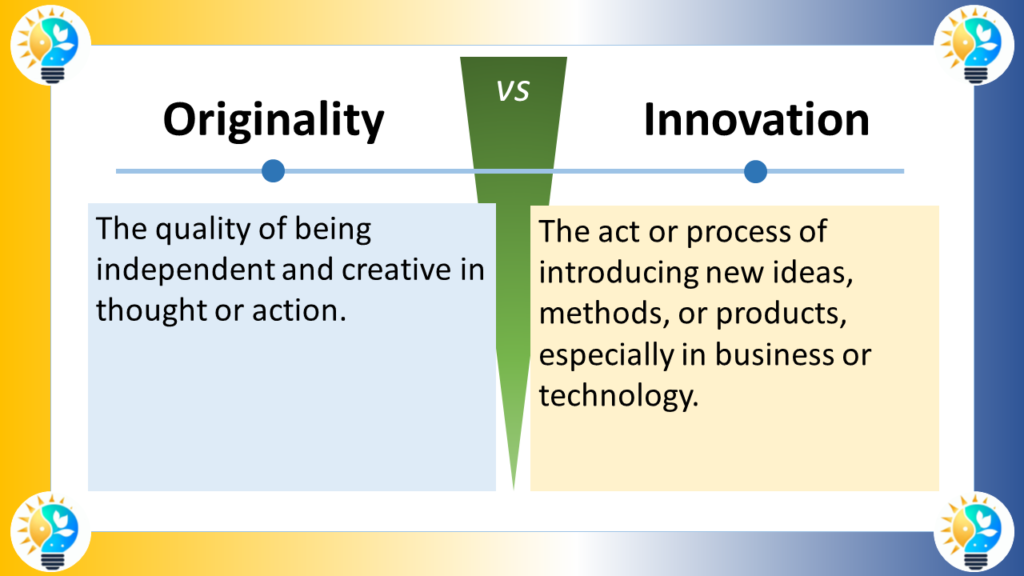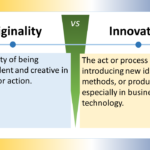The difference between innovation and originality primarily lies in their scope and context.
Originality refers to the quality of being unique or unprecedented in thought or creativity.
Innovation is about the successful implementation of original ideas that lead to new or improved products, services, or processes with practical impact.

Definition
Originality
Originality is the attribute of being novel in one’s thoughts or creations, producing something that has not been done or seen before.
- Characteristics of Originality:
- Creativity: Exhibits imaginative or unique thinking.
- Uniqueness: Offers something distinct from what has previously existed.
- Independent Thinking: Reflects a person’s own ideas or style rather than imitating others.
Innovation
Innovation involves applying creative ideas in a practical way, resulting in the introduction of new or significantly improved goods, services, or methods.
- Characteristics of Innovation:
- Implementation: Focuses on putting ideas into practice.
- Problem-Solving: Addresses specific issues or needs effectively.
- Market or Societal Impact: Creates discernible change or improvement within an industry or community.
More Synonyms on innovation, innovate and innovative
Innovation Terms

Innovation is considered as a driving force in progress.
It includes the introduction of novel ideas, methods, or products that bring positive change and advancement.
For more information about innovations, check our glossary
Relationship and Relevance
Originality is often a critical ingredient in the process of innovation. An original idea can serve as the spark for innovative thinking. However, for originality to transition into innovation, it must be developed, applied, and prove to be impactful in a practical context.
Innovation
- Innovation is about creating something new that disrupts the status quo and changes the way an industry operates.
- Innovation involves developing new technologies, business models or solutions that challenge the existing way of doing things.
- Innovation can redefine industries, like how Uber disrupted the taxi industry or how iTunes changed the music industry.
Originality
- Originality is about creating something new or different, but it does not necessarily change the underlying industry or business model.
- Originality is about incremental changes or new features added to existing products, like new toothpaste flavors or designs. It helps differentiate products but does not fundamentally alter the industry.
- Novelty is often confused with innovation, but not all novel ideas are truly innovative. For an idea to be considered innovative, it needs to drive significant change and impact, not just provide a new feature or product.
In summary, the key distinction is that innovation goes beyond just creating something new - it fundamentally changes how an industry or business operates, while originality is more about incremental improvements or new features within the existing system.
Innovation is about disruption, while originality is about differentiation.
Context for Using Each Term
- Originality is typically discussed in relation to the uniqueness of ideas, artistic expressions, or intellectual creations.
- Innovation is used in contexts where these new ideas are operationalized, leading to tangible advancements or solutions that have a real-world impact.
Example of Utilization
An artist creating a painting with a completely new technique or style exemplifies originality. A tech company that uses a novel, original algorithm to significantly enhance data security in its products demonstrates innovation.
In summary, originality is about the individuality and uniqueness of ideas and creations, while innovation is concerned with the practical application and implementation of those ideas, leading to measurable improvements or advancements in their respective fields.
FAQ
Q1: Can something be both innovative and original?
A1: Yes, many groundbreaking innovations are also highly original. However, an idea can be original without being innovative if it lacks practical application or value creation.
Q2: Is originality necessary for innovation?
A2: While many innovations involve original elements, some innovations can be new combinations or applications of existing ideas, making them less original but still innovative.
Q3: How do businesses balance innovation and originality?
A3: Successful businesses often seek to be original in their approach while ensuring that their innovations create practical value and address market needs.
Q4: Can innovation occur without originality?
A4: Yes, some innovations are new applications or combinations of existing ideas rather than completely original concepts.
Q5: Is originality more valued in certain fields compared to innovation?
A5: Generally, fields like art and pure science may place higher value on originality, while business and applied sciences often prioritize innovation.

